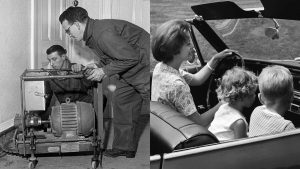27+ Things Baby Boomers Did As Kids That Gen Z Can’t Relate To
There are some things about growing up that apply to every generation, like going through an awkward phase or clashing with parents.
Then, there are things that only baby boomers can fully understand. From chasing the mosquito man to driving exploding cars, younger generations can’t quite relate to these boomer experiences.
Being Around Lead Paint

Today, there can’t be more than 0.06 percent lead in paint since the substance is so dangerous to health. But when boomers were growing up, the public didn’t know this and it was a common ingredient in paint.
Children would be playing innocently, completely unaware that there was lead in the paint on all of their walls. Kids are known to put a lot of things in their mouths, so being around lead products could be highly hazardous.
Bouncing On Trampolines That Don’t Have A Net

Trampolines are pretty dangerous in general, but they are much safer now that they come with safety nets wrapped around the sides. This way, kids don’t bounce off the trampoline and land on hard ground.
This wasn’t the case when boomers were playing on older trampolines. These versions didn’t have a net, so kids would just bounce wildly and hope they didn’t fly off. The more kids were on the trampoline, the more dangerous it became.
Riding Dangerous Skateboards

Skateboards became a commercial product right around the turn of the ’60s, making them a popular toy when boomers were growing up. These versions weren’t like the ones we have today, though.
They were based on the makeshift versions that people had been using for decades prior. These consisted of rollerskate wheels attached to a plank of wood. Over the years, skateboards have developed a more sophisticated design that’s a little more accomodating, especially for kids.
Being Subject To Swirlies

Swirlies are when someone dunks another person’s head in the toilet and flushes. This highly dangerous practice was a normal part of growing up back in the ’60s. When boomers were growing up, bullying was generally regarded as a part of adolescence.
Nowadays, it’s viewed as a travesty that needs to be eradicated. As people started taking bullying more seriously, such overt practices as swirlies became less common. Unfortunately, cyberbullying took its place.
Chasing The Mosquito Man

In areas where insects gather in large quantities during certain seasons, a truck will sometimes drive through spraying insecticide to drive the bugs out of the community. During the ’50s and ’60s, it was common for kids to chase this truck.
The person driving the truck was nicknamed the mosquito man, and children would flock to follow them due to the fog left behind. That changed when DDT was banned, causing people to realize the dangers of kids being exposed to chemicals.
Being A Latchkey Kid

“Latchkey kid” has been a popular term for decades, but baby boomers were especially familiar with its meaning. It describes kids who would return home from school when no one was there and care for themselves until a parent arrived from work.
When boomers were kids, daycares, afterschool programs, and babysitters weren’t as common as they are today. If the parents had to work, then kids had to toughen up and become comfortable with caring for themselves for a few hours.
Not Having A Child-Proofed Home

From cabinet locks to outlet guards, there are too many child-proofing gadgets to count. This wasn’t always the case, though. When boomers were growing up, many parents relied on their own common sense to keep their kids out of harm’s way.
Though it’s impossible to stay on top of a little one’s every move, there was generally less paranoia about all the things that can go wrong at home. In some ways, it was a simpler time.
Playing In Fire Hydrant Water

Playing with fire hydrants is no laughing matter since they release a massive amount of water that could be needed in the event of a local fire. While today doing so would likely get you reported and fined, back in the day fire hydrants were practically a toy.
Boomers would splash around in the water and enjoy themselves as the flushed hydrant flooded the streets. These days, kids stick to supervised slip ‘n slides in the backyard.
Playing With Toys Based On Gender

Modern toys have largely transcended gender stereotypes with colors and designs meant to appeal to all children. This wasn’t the case when boomers were coming up. Boys would play with more traditionally masculine items like cars and sports stuff.
Girls would get toys based on homemaking such as play kitchenware, dolls, and dress-up clothes. If a child showed interest in the toys they weren’t expected to like, they’d probably get teased without anyone thinking twice.
Walking To School

Some kids still walk to school, but it’s generally a less common practice due to the dangers of being youngun out alone. Those who do walk to school often are accompanied by a parent or have a cellphone for emergencies.
That wasn’t the case when boomers were growing up. Walking to school was a complete norm just like playing alone outside was. If they needed something, they’d have to wait until they were at school or they’d try to find a payphone.
Not Wearing Safety Belts

These days, cars go through extensive safety protocols, but that wasn’t always the case. When boomers were growing up, vehicles had flimsy seatbelts that weren’t designed to protect riders quite as well as modern-day ones are.
As a result, many drivers didn’t take seat belt safety very seriously. Kids would often be flailing around in the car and weren’t even always in the back seat. Plus, car seats were just becoming a thing in the ’60s, so little ones were often unrestricted.
Eating With The Family Every Night

Some families still make a point to have dinner together every night, but back when boomers were growing up it was a rule. Whatever kids were doing after school had to be wrapped up in time for dinner, no exceptions.
If boomers were over at a friend’s house, they would likely have dinner seated around the table with their friend’s family! Either way, the kids and the adults all ate together and caught up on one another’s news.
Being Looked After By All Adults

When boomers were growing up, adults in the community all looked after the kids as a whole. Since kids roamed around freely, adults were more apt to look out for any children in the area.
While this sounds like a good thing in theory, it also meant that adults tended to have more authority over children regardless of who they were. These days, kids’ opinions are more highly valued and not all adults are seen as trustworthy.
Playing Outside Alone

Kids still play together outside, but it’s often under supervision or with strict guidelines regarding proximity. When boomers were growing up, such rules either didn’t exist or were far laxer.
Children would run around outside with their parents completely oblivious as to where exactly they were. Some boomers even remember being forced out of the house by guardians so they would find something to do elsewhere. It wasn’t always the safest practice, but it certainly taught independence at a young age.
Making A Blood Pact

Nowadays, friendships are much easier to maintain since people can stay connected through social media, cellphones, and other forms of technology. When boomers were kids, they didn’t have all of these advantages.
As a result, friendships were harder to hold onto. To prove their commitment to a friend, boomers would sometimes make a blood pact. They would cut their hands and shake to symbolize their eternal connection. Modern hygiene practices make kids much less willing to do something so gruesome.
Enjoying Playground Merry-Go-Rounds

Extravagant merry-go-rounds are still a common part of festivals and outdoor malls, but there used to be a more basic version on many playgrounds. These merry-go-rounds didn’t have anything to strap kids in.
They were just four seats facing one another that someone could spin around in a circle while the kids held on for dear life. The simple design was a little too dangerous to survive the years since little ones could so easily get hurt.
Being Looked After By The Lifeguard

Kids playing outside unaccompanied was the norm when boomers were kids, and that was true even when it came to water activities. Kids could go to the pool or even the beach on their own since lifeguards were there to keep them safe.
This meant that lifeguards had to double as babysitters to make sure kids were okay. Even if the parents were there with the kids, it was more acceptable to not be by their side the whole time.
Driving A Car That Might Randomly Explode

When boomers were growing up, cars were becoming more and more stylish. Teenagers couldn’t wait to get their own car and the freedom that came with that.
Without the technological updates we have today, many cars of yesteryear weren’t always the safest. One popular model, the Ford Pinto, would burst into flames if its gas tank was ruptured in a collision! This problem of the cars spontaneously exploding lasted well into the ’70s.
Drinking Water From The Hose

Between water filters, alkaline water, water delivery services, and bottled water, hydration options are bountiful these days. As a result, many kids have a higher standard when it comes to what they drink.
This wasn’t the case when boomers were roaming around at a young age. If they were thirsty and far from home, someone’s hose was the perfect solution. Drinking from the tap, and even from a hose, was much less troubling before the information age.
Shopping For Their Parents

Back in the day, it was common practice to send kids to the store with a note and some money. The children would pick up whatever their parents needed, which sometimes included medication. Nowadays, shopkeepers are much leerier about selling anything to kids.
Merchants will even card those buying certain items like lighters and spray paint. Before lawsuits made these practices common, young boomers had more leeway to buy items. Plus, parents were more willing to have their kids get said items.
Cooking Hot Meals

In the age of the latchkey kids, it was common for minors to prepare meals for themselves or even the entire household. This meant that young people would sometimes have to use unsafe equipment like the oven or stove.
Some preteens may be well versed in the kitchen if they’ve had a home economics class or taken cooking lessons. But when boomers were little, it wasn’t uncommon for kids to handle these things when they were ill-prepared and unsupervised.
Playing In The Street

While kids still play in the streets, nowadays it is often restrained to cul-de-sacs and parental supervision. When boomers were coming up, many parents weren’t as aware of their kids’ playing habits.
Children would play in whatever streets they wanted and, hopefully, get out of the way when a car came. This could be especially dangerous in urban areas where there were more cars and fewer open areas for children to play without much risk.
Biking Without A Helmet

Riding a bike is a fun kids’ pastime, but it requires some safety measures. Especially when kids are learning to ride a bike, they’re often equipped with elbow and knee pads, plus a helmet.
When boomers were learning to ride bikes, they didn’t typically wear all of this protective gear. Even young kids would often avoid wearing a helmet as doing so could mean getting teased by the other children. Being tough was highly valued back then.
Boys Not Being Allowed To Cry

Many male boomers can relate to being taught not to cry when they were growing up. Boys were raised to be tough and taught that showing emotion is a sign of weakness.
As the science of psychology has become more widespread and accepted, emotional health has become more of a priority for men and women. These days, parents are less likely to encourage pushing down emotions since we know they will only surface in unhealthy ways later on.
Playing With Dangerous Science Sets

Combining science and play can be a great way to engage kids, but it requires some supervision. This concept wasn’t completely exercised when boomers were coming up, thanks to something called science sets.
These sets were toys for kids and came with all they needed to do an experiment. The problem is that they weren’t the safest, due to their incorporation of chemicals and explosives. Many parents wouldn’t dream of giving their kids such a toy these days.
Girls Not Being Allowed To Date

Parents still have dating rules for their daughters, but they are generally more relaxed than they were when boomers were coming up. Female boomers often weren’t allowed to date until they were older teens, or even until they were an adult.
These days, there are so many forms of communication and dating apps that kids have a much easier time coupling up, with or without their parents’ knowledge. Back then, it was a little trickier to date, especially if you were a female.
Not Wearing Sunscreen

When boomers were kids, many believed that sunscreen was nothing more than a giant scam. Lifeguards were the ones who most often wore the stuff, but kids often didn’t have to.
As the decades have rolled on, more research on sun damage and the effect of sunscreen has made converts out of many people. Many beach-goers come prepared with sunscreen to put on and reapply, but this wasn’t always the case.
Getting Drafted

While every generation has some relationship with war, boomers experienced it differently due to the draft. Older boomers were just entering adulthood in the 1960s, a time when the draft was imminent.
Younger boomers would have seen relatives get drafted and may have grown up anticipating the day they might be drafted themselves. These experiences impacted many boomers in different ways and shaped their views in ways children of today can’t exactly relate to or fully understand.
Hitchhiking

These days, hitchhiking is seen as a dangerous activity that everyone should avoid, but especially minors! When boomers were teenagers and young adults, though, it was relatively normal to hitchhike.
Likewise, picking up hitchhikers didn’t seem as wild as it does today. People generally had more trust in their neighbors back then. That’s largely changed due to widespread media coverage of crimes. Nightmare stories regarding hitchhikers have left many unwilling to take the risk.
Eating Sugary Cereals

Cereal is still a staple in many households, but parents are savvier than ever when it comes to their children’s diets. When boomers were little, their parents typically cared more about how efficient cereal was than they did about its nutrition.
Cereal was regarded as an easy breakfast and was something that kids could prepare for themselves. Processed foods were much more accepted for their convenience, and as long as the kids liked the taste it was good enough.






